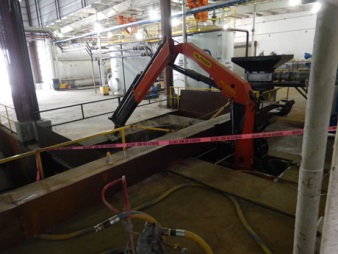Surface – Cement Kiln – On July 13, 2016, a flash fire occurred when a miner was welding near a pit containing flammable vapors. The vapors were emitted from hazardous waste that was being mixed during a trial run to test its suitability as an alternative fuel. The tar-like waste, called Semet, contained benzene (a carcinogen) and other hazardous chemicals. It was unloaded into a hopper and conveyed to a hydrapulper mixer where it was then dissolved in liquid hazardous waste. Nitrogen gas was used to inert the atmosphere in the conveyor system. During the trial run, the facility ran out of nitrogen. Since the waste could not be safely processed without nitrogen, the system was shut down and waste remaining in the hopper was covered with cement kiln dust in an attempt to suppress vapors. Shortly after the system shut down, a contractor checked the atmosphere for explosibility using a portable gas detector and then began welding in the area. He did not check the atmosphere in an adjacent pit that had inadequate ventilation. Welding sparks fell into the pit and ignited flammable vapors that had accumulated at the bottom. The welder suffered second degree burns on his hands, face, and back.

Best Practices
- Remove flammable and combustible materials from areas prior to cutting, welding, or other hot work. A qualified person should monitor nearby areas where heavy vapors could migrate and accumulate.
- Process equipment and systems should be properly designed and completely installed prior to use. A Process Hazard Assessment and Failure Mode and Effects Analysis can identify potential health and safety hazards.
- Inerting systems should be properly designed, installed, adequately filled, and maintained.
- Install fixed monitoring systems with alarms in appropriate locations and calibrate and maintain them regularly.
- Do not work in areas where concentrations of vapors can be immediately fatal (Lower Explosive Limit), Immediately Dangerous to Life or Health, or where they exceed permissible exposure limits (PELs) to produce adverse health effects.
- Minimize or eliminate hazards by using appropriate engineering and administrative controls.
- Ventilation systems should be properly designed, installed, and maintained.
- Train miners on chemical hazards and emergency response procedures.
